System Engineering & Design Architecture by Sander R.B.E. Beals (top novels .txt) 📖
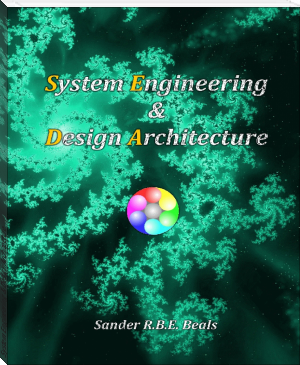
- Author: Sander R.B.E. Beals
Book online «System Engineering & Design Architecture by Sander R.B.E. Beals (top novels .txt) 📖». Author Sander R.B.E. Beals
But, back to the basics. The final outcome of my drawing exercises at the start of the Millennium was twofold:
The SevenSphere showed me a distinct boundary in the logical development of the sequence based on Yin and Yang, in that it was only possible to maintain the same diameter of circles in the evolution of the series until there was one sphere at the center and exactly six surrounding it. From there onwards, the diameter of the center sphere would have to be relatively larger with regard to the surrounding satellites, and the total diameter of the form itself.
The evolution of the first sequence took exactly ten steps, as can be seen below. Maybe that is why the base-10 numerical system has been used in the western world until now...
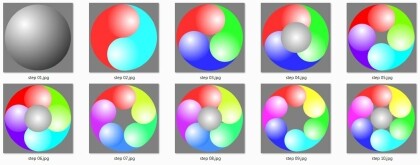
Back then I didn't realize that there were exactly ten steps from oneness to SevenSphere, but I did know that further evolutionary steps would make distinct changes in the evolution of the spheres: the center sphere would have to become relatively larger with every satellite sphere added, and the satellite spheres, if all given the same diameter would have to become relatively smaller. Let me see if I can draw you a picture on what's left of this page:

You get the picture, I presume... As the number of satellites grows, the ratio of the diameter of the center sphere over the diameter of the satellites grows. Based on the first five images I drew, I have established that the ratio grows a factor of about 1.3 with every next phase. Apparently, even inner space has three dimensions, but they are on the opposite side of the decimal point. At least that's what came out of the first five images. After also measuring the phases from the first sequence that have holes in them, I come to the next graph:
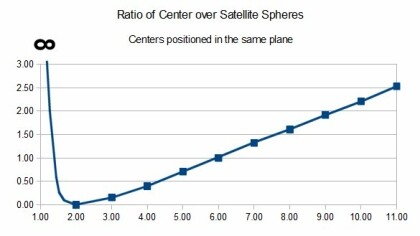
The significant part here is that the first image, the fully grey sphere of Oneness is in fact also the ultimate end of the developing series, where the center sphere or system has been able to fully absorb the space of the satellites around it: both ends of this graph will eventually reach Infinity.
We all learn all the time: for Example, the images I drew back in 2001 were an extension of Apollonian gaskets, as I just learned from a relevant web page which referred me back to Wikipedia (see image on next page). The main difference is, that I also drew circles within circles, because that seemed right at the time. When asked to explain why I did that, my enhanced insight from further experience would now make me explain it in my new system-oriented approach: If we consider the Apollonian gasket as a set of systems (or the sphere for the visually more evolved humans) we see that these images can be seen as a number of interacting systems, because circles and spheres are also systems, but of extreme simplicity. From that we can also see they have interfaces, where the circles or spheres touch. The learning process is nothing else but a system creating an image of the other spheres in its environment inside itself, but it can only do so via the interfaces it has with its direct neighbors (where the circles or spheres touch). The bigger systems may be connected to many surrounding smaller systems, but they have no direct insight in the connections those systems have to one another. Sure, they can query their surrounding systems for info about such relationships, but who is to tell them that those systems are telling them the right thing? The big system may think it is in a stable position, while all the time it is being moved around by the smaller ones creating a vacuum in front of it, and a buildup of pressure behind it. So yes, the masses do have power over the bigger systems, since the combined effort of the smaller systems is spread in such a way, that the bigger ones basically get the same information from their surrounding systems, and cannot make heads or tails from it: just consider the rightmost sphere in the image above, where the surrounding colored spheres basically feed the center sphere all colors of the rainbow, but are in fact all together feeding in the same overall info (white light). Now in the 2D example below, the smaller circles may only form interfaces outside the bigger ones, and thus can be virtually cut off from their smaller neighbors because of them ending in the ever sharper spikes where only a relatively tiny interface is possible.
I lack the mathematical skills to prove my next statement to you, but just consider the image on the right below next: we can clearly see, that no true separations of the smaller green spheres exist. The extra dimension gives the smaller spheres the freedom to evade such separating areas, and keep contact around them with one another. Even more so, if the image was one big sphere and numerous surrounding green ones, the sum total would be green all over, unless the green ones decide to let the grey one show its skin.
Apollonian gasket (2D circle packing)
(reproduced from Wikipedia)
Apollonian spheres (3D sphere packing)
(reproduced from Wikipedia)
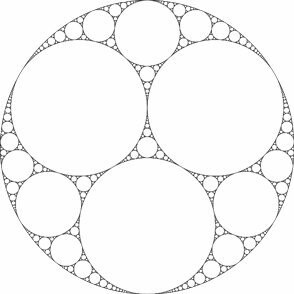

Pretty deep material, right? Now imagine the big grey one showing in the image on the right. It is basically an internal system of the total system, exposed to the outside. The next logical step to 'fix' this would be to make more growth in green cells, whose division strategies will eventually cover the wound just like they do in humans. The only difference here is that our small systems are red blood cells, and the wound is basically anything from a cat's scratch to a broken bone.
The bigger system inside may then never know it has been completely surrounded by green little spheres (or blue Smurfs, just like Gargamel) Yes, Peyo explained this in a similar manner, that is enjoyable for both kids and adults... But where he explained it to the subconscious, I'm targeting the conscious mind.
Back to the circles within circles though: this is where the persistence of vision or imagination for most humans does not meas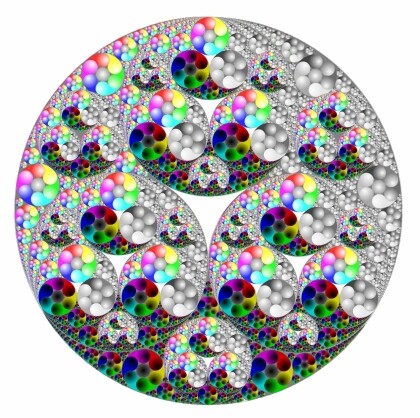 ure up to the challenge: if smaller circles would also be within the bigger ones, the circumference of the bigger circles will be almost invisible to the common observer. Just check the image on the right, if it weren't for the triangle in the middle you might never have seen the three major circles.... And keep in mind, that beyond the three dimensions of space and the one of time, we have countless other dimensions to keep track of: most of us juggle Home, Work, Education, and various other concerns, distinctions we too make for our own peace of mind: you wouldn't want to have the work piece take up part of the home piece, or even the home peace.....
ure up to the challenge: if smaller circles would also be within the bigger ones, the circumference of the bigger circles will be almost invisible to the common observer. Just check the image on the right, if it weren't for the triangle in the middle you might never have seen the three major circles.... And keep in mind, that beyond the three dimensions of space and the one of time, we have countless other dimensions to keep track of: most of us juggle Home, Work, Education, and various other concerns, distinctions we too make for our own peace of mind: you wouldn't want to have the work piece take up part of the home piece, or even the home peace.....
But then again, they are only artificial boundaries: we apply them, because we need to be able to handle them all: Divide and Conquer wasn't discovered for nothing. And of course the boundaries aren't always that clear: the moment I come into a healthy sum of money, the system called work may have to deal with a loss of personnel knowhow, which of course I will try to transfer to colleagues during my last months there. That is basically the bigger system called 'me' deciding it doesn't need a certain subsystem anymore, and discarding it. But also note that that means another subsystem of mine (wanting to win the lottery) has suddenly become realized and thus made the work part obsolete. But also note that the employee I am is only seen as a minute subsystems of the company, which will not be shaken or stirred if the employee leaves: they have many like that left....
Still, we may be part of numerous systems like for instance:
Partner of a nice lady or guy
Father or mother to any number of lovely kids
Member of a family unit
Self-employed business person
Employee of a company
Citizen of a country
Member of a church
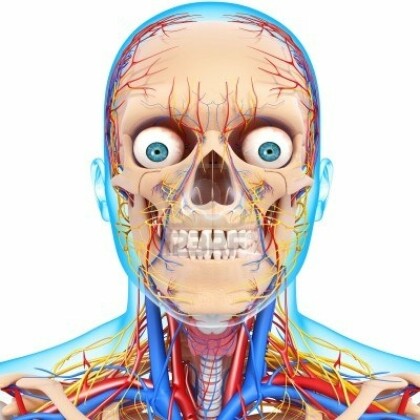 Supporter of a local soccer team
Supporter of a local soccer team
Buddy to several colleagues
Gamer on WarCraft or something similar
You name a few other ones....
Too many to see it clearly right? Point is, since all are thought forms, they do not impinge on one another inside our minds: unlike the image on the right here, subsystems in the world of ideas do not take up space, and as such do not need to avoid one another in that way. And they can always be made to work again by escalating to the next higher level in order to fix things. Like I would ask to speak to my CEO if my boss gives me trouble, and it always is just like Einstein said:
"A problem can only be solved from a higher awareness than the one that detected it"
So in order for me to understand the more grand circles of the obvious, my subconscious made me into a sort of a recluse: I don't normally go out to experience the everyday life unless there is a solid reason to do so, and I am not a member of many bigger groups except the global culture we call Humanity. Father to two lovely daughters alright, but no partner at the moment because writing is relatively more important.
As I reread this my system plays me Sting: “If I ever lose my faith in you”, which according to the lyrics is all about that feeling of not belonging anywhere but still being at the center of it all. Such 'coincidences' are way too coincidental to ever make me lose my faith in You!
On the other hand, I do go out of my way to assist anyone needing help, because of this peculiar desire of mine to see everyone happy. And the weird part is, since I radiate this to the world outside, I also see it reflected back to me: there may be 'systems' out there busy to try and draw me into their bigger groups, but there are just as many more free radicals out there to assist in any way they can simply because that is the total of the image of the system topography I uncovered from my experiences over the past 49 years... (as if time matters)
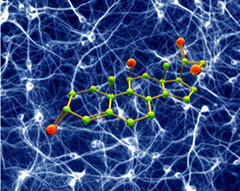 Now let's just view the spheres in spheres thing another way: since the spheres are the center concept here, and the connections between them signify the interfaces that relate spheres to one another, do you have any idea what this whole cluster of tightly packed interacting spheres looks like? If we see the spheres as point charges, it is quite like the centers of the spheres are neurons, and the connecting interfaces are the dendrites and axons that send the signals from one neuron to another. This way, the set of neurons inside a system may physically be totally differently packed, but they'll fire according to the associations we make on a regular basis with regard to those pieces of outside information! Even more so, since the sets for the various senses are in certain areas of the brain, and the acting together of these input devices makes sure neurons are firing together, they also wire together: if you hear the music it isn't hard to actually know the lyrics, even if the music itself is Karaoke. Likewise, your learning of various languages makes sure the neurons for the various words in different languages fire together, along with the neurons that only signify the sounds languages have in common. So the idea that any language has a finite set of three letter 'syllables' is just common sense, because the neurons that associate with the combinations fire in sequence, and when
Now let's just view the spheres in spheres thing another way: since the spheres are the center concept here, and the connections between them signify the interfaces that relate spheres to one another, do you have any idea what this whole cluster of tightly packed interacting spheres looks like? If we see the spheres as point charges, it is quite like the centers of the spheres are neurons, and the connecting interfaces are the dendrites and axons that send the signals from one neuron to another. This way, the set of neurons inside a system may physically be totally differently packed, but they'll fire according to the associations we make on a regular basis with regard to those pieces of outside information! Even more so, since the sets for the various senses are in certain areas of the brain, and the acting together of these input devices makes sure neurons are firing together, they also wire together: if you hear the music it isn't hard to actually know the lyrics, even if the music itself is Karaoke. Likewise, your learning of various languages makes sure the neurons for the various words in different languages fire together, along with the neurons that only signify the sounds languages have in common. So the idea that any language has a finite set of three letter 'syllables' is just common sense, because the neurons that associate with the combinations fire in sequence, and when





Comments (0)